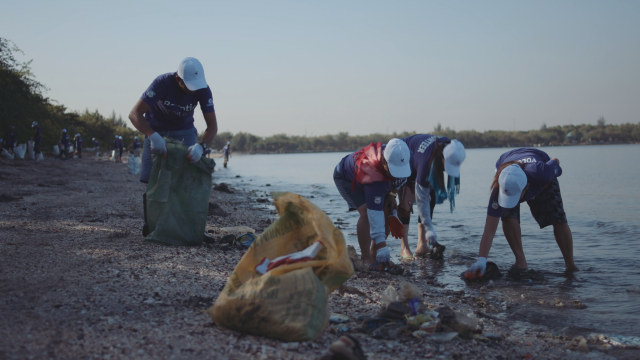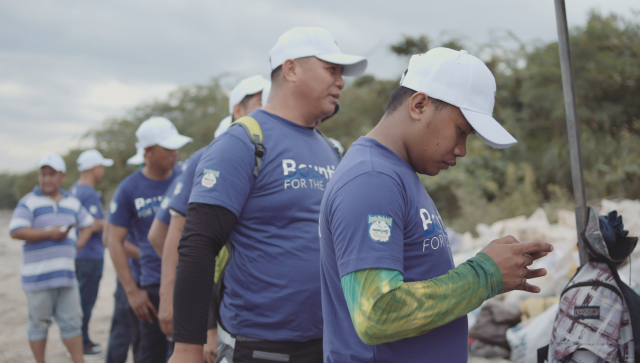How much incentive do 224 people need to remove three tons of trash from a beach in Manila Bay? According to a recent event organized by the Bounties Network along with ConsenSys Social Impact and Coins.ph, the answer is $500 worth of cryptocurrency.
During the first two days of December 2018, members of these three teams met with Manila locals to pick up garbage in exchange for small bounties. Coins.ph provided many of the participants’ first ever crypto wallets.
This is the type of incentives model the Bounties Network has been facilitating since Mark Beylin, 23, created the network while finishing college in Waterloo, Ontario in 2017. Beylin interned at ConsenSys in 2016, so he was familiar with the Ethereum-focused company when he presented his idea for a bounty network a year later. ConsenSys agreed to work with Beylin, eventually leading to this massive trash pick-up.
Beylin didn’t initially conceive of Bounties Network as a vehicle for social good. Noticing bounties taking off as a way to get developers to do things like correct bugs, Beylin simply wanted to see “what would happen if we started applying monetary incentives to behaviors that don’t normally get incentivized,” he tells BREAKERMAG.
Today, Bounties Network looks like a developer’s Task Rabbit. There are bug bounties, requests for dapp demos, and a reward for making a memes in time for the upcoming ETHDenver conference. There’s also a bounty for getting someone named Peter to watch Mean Girls, for which 0.08 ether has been paid out.
“I’d originally been kind of skeptical about the social impact-related stuff [on the platform],” says Beylin. He didn’t think it would catch on. Beylin was “shocked” by how many people ultimately came out to pick up trash in Manila two months ago—a location chosen in part because ConsenSys already has a presence there—so he’s thinking of ways to keep up the good work. We spoke to Beylin about the challenges of explaining crypto incentives to fishermen in Manila, organizing a trash pickup from across the globe, and stopping ocean pollution at its source. This interview has been edited and condensed for clarity.
I’ve noticed a lot of variation among the bounties offered on Bounties Network. What is the weirdest bounty you’ve seen put up there?
I put one up last year out of curiosity. I wanted somebody to make a mash-up of some songs for me. The songs were a Kanye West song and Beethoven’s Fifth Symphony. Somebody actually did the bounty and made the track. It ended up being better than I expected.
How much of a bounty did they get for doing that?
I think it was $50 or $75.
Was it surprising when you started to see social good use cases proposed on the platform, if you were originally imagining it more for freelancers?
Yeah. I wasn’t sure how much interest there would be both from organizations who might want to fund bounties or for people who would be doing the work, picking up trash for $5 or $10. It started out by us putting up this [remote trash collecting] bounty and saying, “We’ll see what happens.” Because the response was so good, we said, “We should double down on this,” and make it a more holistic, on-the-ground experience that can go on in perpetuity after we’re gone. That’s what we did in Manila. I was even shocked on the ground by how much interest there was from people to start earning cryptocurrency, many of whom had never even heard of it before.
Picking up trash in Manila Bay. Photo courtesy of Mark Beylin

You’re located in Toronto, and you posted about the Manila trash cleanup on the Bounties Network website—but how did you get people to physically show up for a cleanup in the Philippines?
One of the things that was really important for us from the get-go was partnering with local organizations. We realized we didn’t want to just come in and dictate terms. We wanted to plug in as much as possible to volunteer organizations that already existed and [with] partners on the ground that could help us take care of the trash after it was cleaned up. One of the organizations we partnered with was a fishermen’s volunteer group that brought in a very large cohort of volunteers who had already been cleaning up the beaches and were happy about the extra incentives. Beyond that, we had a page up that we use to advertise the event in advance.
I read your Medium post about this event, and it seems like a lot of the participants who were from Manila were not very familiar with blockchain technology. How did you explain blockchain-based incentives to them?
I’ve been teaching people about blockchain for a long time. The key is always to simplify as much as possible. In Manila, a lot of it was figuring out the examples that might be relevant for people. For instance, in the Philippines, the remittances market is really booming because a lot of Filipino people go work abroad and send cash back home on a regular basis, and they pay pretty significant fees.
What we did is explain [cryptocurrency] through that use case: “What if you could have this system that works alongside your existing monetary systems but allowed for way cheaper transactions? You could send money globally in the blink of an eye with lower fees.” We explained tokens and said the token they would be earning—ether—would be convertible using a local exchange into phone credits or fiat cash, or they could just hold onto it themselves.
Photo courtesy of Mark Beylin

Do you think you got any Ethereum converts from that event?
I think so. How many is hard to say. We were aiming less about having the maximum number of people attend the event and more for a study of how it would go on the ground so we could potentially scale it more later—and also to create more personal relationships with the people we were doing the work with. In terms of numbers, though, half of them or a quarter of them might still be holding their ETH.
How many people showed up during the two-day event?
I think 224 people, but not all of them fulfilled the bounty. [118 were paid.] A lot of people who got there, especially from the fisherman’s organization, decided that they didn’t want to get paid. They didn’t need to. They were happy to take a T-shirt and food. They’re already doing this kind of cleanup on the beach, so I think they were just delighted that people had shown an interest.
Where did the trash collected ultimately end up?
We partnered with a company called Cavitex. They’re located close to where we did the cleanup. What they do is sort out the trash and melt it into various objects. They make safety cones, pots for plants, and, most importantly, they make these tiles that you can use for walkways.
Can you conceive of a project the Bounties Network could facilitate that addresses the source of the trash you were picking up?
That’s something I’ve been thinking about a lot. For instance, we can think about where this trash is coming from, and if there are particular organizations that we know are producing a lot of this trash. What we could do in theory is put up bounties for them [that reward them for better practices].
The challenging part is that the way most trash gets into the ocean is decentralized. It’s people on the beach losing shoes, or plastic wrappers, and that all aggregates in the ocean and then comes into Manila Bay. Unless we can pinpoint particular individuals or organizations that we can incentivize, just incentivizing people to throw away their trash, it’s very ephemeral.
The reason why we highlighted the social aspect of the event was—this is well known in the NGO world—trash cleanups are typically less about the amount of trash that gets picked up, and more about teaching the individuals who are picking up the trash how big of a problem it is and how much of an impact they could have in fixing it. In the few weeks following the pickup, I have been more keen to pick up litter when I see it on the ground.
This article has been updated to reflect that $500 were awarded in bounties for cleaning trash off the beach in Manila during the December event, not $700 as originally reported. The $700 figure included a separate trash pickup bounty organized through Bounties Network.